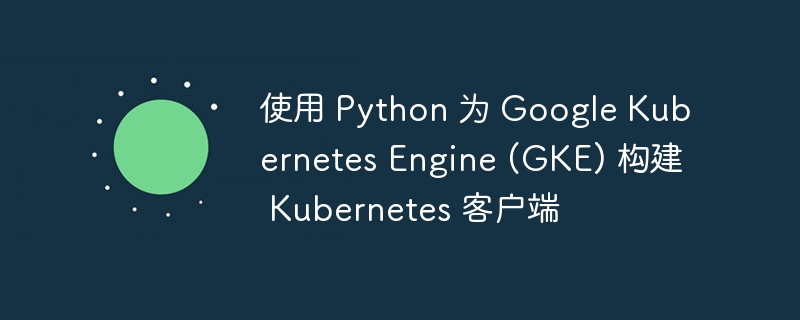使用 Python 为 Google Kubernetes Engine (GKE) 构建 Kubernetes 客户端
来源:dev.to
时间:2024-12-17 17:55:01 148浏览 收藏
偷偷努力,悄无声息地变强,然后惊艳所有人!哈哈,小伙伴们又来学习啦~今天我将给大家介绍《使用 Python 为 Google Kubernetes Engine (GKE) 构建 Kubernetes 客户端》,这篇文章主要会讲到等等知识点,不知道大家对其都有多少了解,下面我们就一起来看一吧!当然,非常希望大家能多多评论,给出合理的建议,我们一起学习,一起进步!

这篇博文介绍了一种使用 python 为 gke 创建 kubernetes 客户端的有效方法。通过利用 google-cloud-container、google-auth 和 kubernetes 库,无论您的应用程序是在本地运行还是在 google cloud 上运行,您都可以使用相同的代码与 kubernetes api 进行交互。这种灵活性来自于使用应用程序默认凭证(adc)来验证和动态构建 kubernetes api 交互所需的请求,从而无需使用额外的工具或配置文件(如 kubeconfig)。
本地运行时,常见的方法是使用 gcloud 容器集群 get-credentials 命令生成 kubeconfig 文件并使用 kubectl 与 kubernetes api 交互。虽然此工作流程对于本地设置来说是自然且有效的,但在 cloud run 或其他 google cloud 服务等环境中却变得不太实用。
借助 adc,您可以通过动态配置 kubernetes 客户端来简化对 gke 集群的 kubernetes api 的访问。这种方法可确保以一致、高效的方式连接到集群,而无需管理外部配置文件或安装额外工具的开销。
先决条件
1. 使用 google cloud 进行身份验证
如果您在本地运行代码,只需使用以下命令进行身份验证:
gcloud auth application-default login
这将使用您的用户帐户凭据作为应用程序默认凭据(adc)。
如果您在 cloud run 等 google cloud 服务上运行代码,则无需手动处理身份验证。只需确保该服务具有正确配置的服务帐户,并具有访问 gke 集群所需的权限。
2. 收集您的集群详细信息
运行脚本之前,请确保您了解以下详细信息:
- google cloud 项目 id:托管 gke 集群的项目的 id。
- 集群位置:集群所在的区域或可用区(例如 us-central1-a)。
- 集群名称:您要连接的 kubernetes 集群的名称。
脚本
下面是为 gke 集群设置 kubernetes 客户端的 python 函数。
from google.cloud import container_v1
import google.auth
import google.auth.transport.requests
from kubernetes import client as kubernetes_client
from tempfile import namedtemporaryfile
import base64
import yaml
def get_k8s_client(project_id: str, location: str, cluster_id: str) -> kubernetes_client.corev1api:
"""
fetches a kubernetes client for the specified gcp project, location, and cluster id.
args:
project_id (str): google cloud project id
location (str): location of the cluster (e.g., "us-central1-a")
cluster_id (str): name of the kubernetes cluster
returns:
kubernetes_client.corev1api: kubernetes corev1 api client
"""
# retrieve cluster information
gke_cluster = container_v1.clustermanagerclient().get_cluster(request={
"name": f"projects/{project_id}/locations/{location}/clusters/{cluster_id}"
})
# obtain google authentication credentials
creds, _ = google.auth.default()
auth_req = google.auth.transport.requests.request()
# refresh the token
creds.refresh(auth_req)
# initialize the kubernetes client configuration object
configuration = kubernetes_client.configuration()
# set the cluster endpoint
configuration.host = f'https://{gke_cluster.endpoint}'
# write the cluster ca certificate to a temporary file
with namedtemporaryfile(delete=false) as ca_cert:
ca_cert.write(base64.b64decode(gke_cluster.master_auth.cluster_ca_certificate))
configuration.ssl_ca_cert = ca_cert.name
# set the authentication token
configuration.api_key_prefix['authorization'] = 'bearer'
configuration.api_key['authorization'] = creds.token
# create and return the kubernetes corev1 api client
return kubernetes_client.corev1api(kubernetes_client.apiclient(configuration))
def main():
project_id = "your-project-id" # google cloud project id
location = "your-cluster-location" # cluster region (e.g., "us-central1-a")
cluster_id = "your-cluster-id" # cluster name
# retrieve the kubernetes client
core_v1_api = get_k8s_client(project_id, location, cluster_id)
# fetch the kube-system namespace
namespace = core_v1_api.read_namespace(name="kube-system")
# output the namespace resource in yaml format
yaml_output = yaml.dump(namespace.to_dict(), default_flow_style=false)
print(yaml_output)
if __name__ == "__main__":
main()
它是如何运作的
1. 连接gke集群
get_k8s_client 函数首先使用 google-cloud-container 库从 gke 获取集群详细信息。该库与 gke 服务交互,允许您检索集群的 api 端点和证书颁发机构 (ca) 等信息。这些详细信息对于配置 kubernetes 客户端至关重要。
gke_cluster = container_v1.clustermanagerclient().get_cluster(request={
"name": f"projects/{project_id}/locations/{location}/clusters/{cluster_id}"
})
需要注意的是,google-cloud-container 库是为与 gke 作为服务交互而设计的,而不是直接与 kubernetes api 交互。例如,虽然您可以使用此库检索集群信息、升级集群或配置维护策略(类似于使用 gcloud 容器集群命令执行的操作),但您无法使用它直接获取 kubernetes api 客户端。这种区别就是为什么该函数在从 gke 获取必要的集群详细信息后单独构建 kubernetes 客户端。
2. 使用 google cloud 进行身份验证
为了与 gke 和 kubernetes api 交互,该函数使用 google cloud 的应用程序默认凭据 (adc) 进行身份验证。以下是身份验证过程的每个步骤的工作原理:
google.auth.default()
此函数检索代码运行环境的 adc。根据上下文,它可能会返回:
- 用户帐户凭据(例如,来自本地开发设置中的 gcloud auth 应用程序默认登录)。
- 服务帐户凭据(例如,在 cloud run 等 google cloud 环境中运行时)。
它还会返回关联的项目 id(如果可用),尽管在本例中仅使用凭据。
google.auth.transport.requests.request()
这将创建一个 http 请求对象,用于处理与身份验证相关的网络请求。它在内部使用 python 的 requests 库,并提供标准化的方法来刷新凭据或请求访问令牌。
creds.refresh(auth_req)
当使用 google.auth.default() 检索 adc 时,凭证对象最初不包含访问令牌(至少在本地环境中)。 fresh() 方法显式获取访问令牌并将其附加到凭证对象,使其能够对 api 请求进行身份验证。
以下代码演示了如何验证此行为:
# obtain google authentication credentials
creds, _ = google.auth.default()
auth_req = google.auth.transport.requests.request()
# inspect credentials before refreshing
print(f"access token (before refresh()): {creds.token}")
print(f"token expiry (before refresh()): {creds.expiry}")
# refresh the token
creds.refresh(auth_req)
# inspect credentials after refreshing
print(f"access token (after): {creds.token}")
print(f"token expiry (after): {creds.expiry}")
示例输出:
access token (before refresh()): none token expiry (before refresh()): 2024-11-24 06:11:19.640651 access token (after): ********** token expiry (after): 2024-11-24 07:16:06.866467
调用refresh()之前,token属性为none。调用刷新()后,凭证将填充有效的访问令牌及其到期时间。
3.配置kubernetes客户端
kubernetes 客户端是使用集群的 api 端点、ca 证书的临时文件和刷新的承载令牌进行配置的。这确保客户端可以安全地进行身份验证并与集群通信。
configuration.host = f'https://{gke_cluster.endpoint}'
configuration.api_key['authorization'] = creds.token
ca 证书临时存储并由客户端引用以进行安全 ssl 通信。通过这些设置,kubernetes 客户端已完全配置并准备好与集群交互。
示例输出
这是 kube-system 命名空间的 yaml 输出示例:
api_version: v1
kind: Namespace
metadata:
annotations: null
creation_timestamp: 2024-11-24 04:49:48+00:00
deletion_grace_period_seconds: null
deletion_timestamp: null
finalizers: null
generate_name: null
generation: null
labels:
kubernetes.io/metadata.name: kube-system
managed_fields:
- api_version: v1
fields_type: FieldsV1
fields_v1:
f:metadata:
f:labels:
.: {}
f:kubernetes.io/metadata.name: {}
manager: kube-apiserver
operation: Update
subresource: null
time: 2024-11-24 04:49:48+00:00
name: kube-system
namespace: null
owner_references: null
resource_version: '15'
self_link: null
uid: 01132228-7e86-4b74-8b78-8ceaa8df9913
spec:
finalizers:
- kubernetes
status:
conditions: null
phase: Active
结论
这种方法强调了使用相同代码与 kubernetes api 交互的可移植性,无论是在本地运行还是在 cloud run 等 google cloud 服务上运行。通过利用应用程序默认凭证 (adc),我们演示了一种灵活的方法来动态生成 kubernetes api 客户端,而无需依赖预先生成的配置文件或外部工具。这使得构建能够无缝适应不同环境的应用程序变得容易,从而简化了开发和部署工作流程。
本篇关于《使用 Python 为 Google Kubernetes Engine (GKE) 构建 Kubernetes 客户端》的介绍就到此结束啦,但是学无止境,想要了解学习更多关于文章的相关知识,请关注golang学习网公众号!
-
501 收藏
-
501 收藏
-
501 收藏
-
501 收藏
-
501 收藏
-
264 收藏
-
363 收藏
-
171 收藏
-
216 收藏
-
160 收藏
-
170 收藏
-
367 收藏
-
231 收藏
-
260 收藏
-
272 收藏
-
369 收藏
-
249 收藏
-

- 前端进阶之JavaScript设计模式
- 设计模式是开发人员在软件开发过程中面临一般问题时的解决方案,代表了最佳的实践。本课程的主打内容包括JS常见设计模式以及具体应用场景,打造一站式知识长龙服务,适合有JS基础的同学学习。
- 立即学习 543次学习
-

- GO语言核心编程课程
- 本课程采用真实案例,全面具体可落地,从理论到实践,一步一步将GO核心编程技术、编程思想、底层实现融会贯通,使学习者贴近时代脉搏,做IT互联网时代的弄潮儿。
- 立即学习 516次学习
-

- 简单聊聊mysql8与网络通信
- 如有问题加微信:Le-studyg;在课程中,我们将首先介绍MySQL8的新特性,包括性能优化、安全增强、新数据类型等,帮助学生快速熟悉MySQL8的最新功能。接着,我们将深入解析MySQL的网络通信机制,包括协议、连接管理、数据传输等,让
- 立即学习 500次学习
-

- JavaScript正则表达式基础与实战
- 在任何一门编程语言中,正则表达式,都是一项重要的知识,它提供了高效的字符串匹配与捕获机制,可以极大的简化程序设计。
- 立即学习 487次学习
-

- 从零制作响应式网站—Grid布局
- 本系列教程将展示从零制作一个假想的网络科技公司官网,分为导航,轮播,关于我们,成功案例,服务流程,团队介绍,数据部分,公司动态,底部信息等内容区块。网站整体采用CSSGrid布局,支持响应式,有流畅过渡和展现动画。
- 立即学习 485次学习
